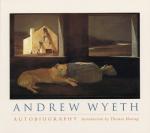
|
| Name: _________________________ | Period: ___________________ |
This test consists of 15 multiple choice questions and 5 short answer questions.
Multiple Choice Questions
1. Who was the subject of the painting, "Roasted Chestnuts"?
(a) Evan Paulson.
(b) Allen Messersmith.
(c) Sam Delgado.
(d) Abe Maino.
2. The 1967 painting "The Sweep" featured ______________________.
(a) Birds fixing a nest.
(b) A baseball game.
(c) A woman cleaning house.
(d) The wet sky over the ocean.
3. How did the painting, "Buzzard's Glory" get its name?
(a) It was created in an area called Buzzard's Glory.
(b) It was a nickname of the boy in the painting.
(c) It was an homage to dead animals.
(d) It was a joke the boy in the painting told him.
4. Wyeth considered which painting to be one of the best watercolors he ever did?
(a) The Mill.
(b) Black Velvet.
(c) Fog.
(d) Cranberries.
5. What kind of dog was Nellie in "Groundhog Day" painted in 1958?
(a) German Shepherd.
(b) Poodle.
(c) Collie.
(d) Jack Russell Terrier.
6. In "Wood Stove" painted in 1962, Wyeth depicted a house fragile on the outside but _______________________.
(a) As strong as a rock inside.
(b) Filled with spirituality inside.
(c) Held up with love from the inside.
(d) Full of secrets on the inside.
7. What was the subject in "The Trophy" in 1963?
(a) Moose horns.
(b) A blue ribbon.
(c) Raspberries.
(d) Milk cans.
8. Who can barely be seen in the painting, "Geraniums'?
(a) Betsy Wyeth.
(b) Christina Olson.
(c) Helene Banco.
(d) Amy Madigan.
9. What did Wyeth hope to capture in the 1968 painting, "Alvaro and Christina"?
(a) A true love story.
(b) A lifelong friendship.
(c) A divorce.
(d) The Olsons' environment.
10. Whose house was featured in "Brown Swiss" in 1957?
(a) The Segers.
(b) The Portmans.
(c) The Kuerners.
(d) The Wyeths.
11. At whose home was the item located in "The Trophy"?
(a) Karl Kuerner.
(b) Christina Olson.
(c) Sam Knox.
(d) Adam Shade.
12. In "Dam Breast" painted in 1970, Wyeth was drawn in by a _______________________.
(a) A plume of water froth mixed with ice.
(b) A a leaden sky.
(c) A horse and buggy.
(d) A rolling hill.
13. Who was depicted in "Wood Stove"?
(a) Sara.
(b) Betsy.
(c) Christina.
(d) Anna.
14. What was Wyeth's message in "Weatherside"?
(a) Everything has some redeeming quality.
(b) You should always check the weather before boating.
(c) Things do not last.
(d) People can weather any storm if they want to.
15. "Onions" in 1955 is a painting of Bermuda onions __________________.
(a) In a field.
(b) In a barn.
(c) On a cutting block.
(d) In a basket.
Short Answer Questions
1. What inspired Wyeth to paint "Snow Flurries" in 1953?
2. What did Siri Erikson represent for Wyeth?
3. Who was the subject in "Gunning Rocks" painted in 1966?
4. In what state was the scene in "Marsh Hawk" located?
5. "Winter Bees" in 1959 is a painting of a ________________.
|
This section contains 427 words (approx. 2 pages at 300 words per page) |

|




